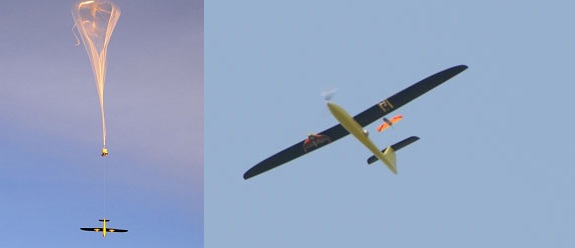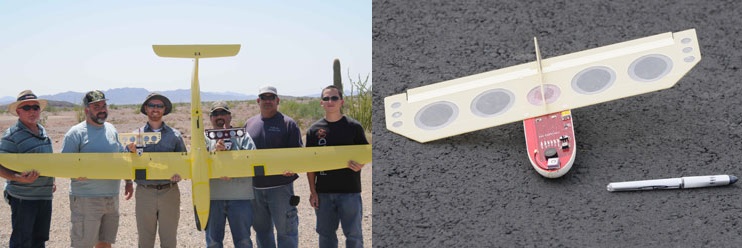The U.S. Navy Research Lab's Tempest Unmanned Aerial Vehicle (UAV) may not be the mother of all drones, but it is the mother of two drones, at least. Hoisted up to 53,000 feet onto a high-flying trajectory via releasable balloon, the Tempest UAV "gives birth" in flight, launching a pair of mini "Cicada" drones.
The tiny Cicadas are an exercise in efficiency, with their logic boards doubling as wings. The Cicada UAVs are gliders, complete with smartphone-like two-axis gyroscopes and GPS circuits for navigation.
Several variants have been produced. The Cicada Mark I can be launched by firing it from a gun into the air. The Cicada Mark III is designed with special wings for improved range and stability, and is the model used by Tempest "mothership". Cicada stands for Close-In Covert Autonomous Disposable Aircraft.

The drone reportedly has a custom algorithm that accurately estimates wind speed and magnitude without any purpose driven sensors (presumably the algorithm is based on drift from the expected navigation path. A Cicada launched from an altitude of 18,000 feet was able to travel 11 miles, landing within 15 feet of its desired target, a remarkable feat. The drone has been hardened to endure winds up to 40 knots.
Lithium ion batteries -- the same kind you could find in your smart phone -- power the drone. The high-altitude versions have heaters to prevent the frigid temperatures of the upper atmosphere from harming the circuit board.
Comments Chris Bovais, NRL aeronautical engineer; "It gets quite cold at 30,000 feet - in the minus 57 degree Celsius range. So, we have to keep the batteries and electronics healthy and working."
The tiny drone will eventually be equipped with tiny imaging sensors and networking sensors as they near combat readiness.

For conspiracy fans out there, the petite declassified Cicada is bird-sized -- just a bit larger that the infamous "dragonfly drone" that protesters in Washington D.C. claimed was "spying" on their activities. The government of course denied all knowledge of cooking up secret robotic dragonfly minions.



Reader Comments
to our Newsletter